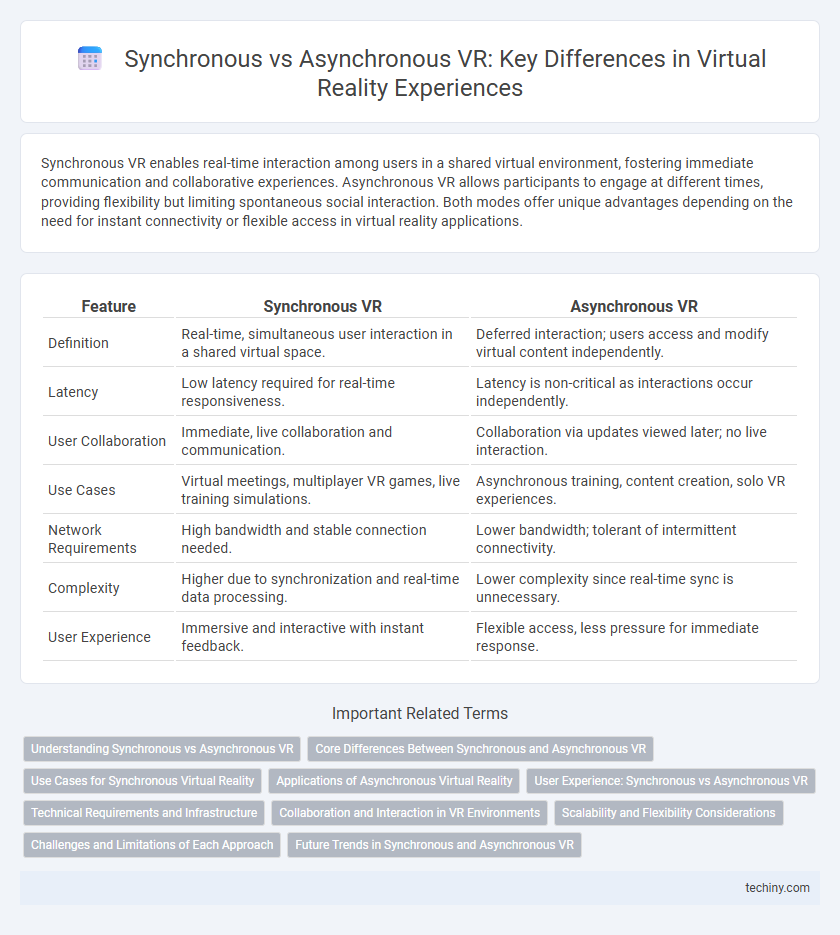Synchronous VR enables real-time interaction among users in a shared virtual environment, fostering immediate communication and collaborative experiences. Asynchronous VR allows participants to engage at different times, providing flexibility but limiting spontaneous social interaction. Both modes offer unique advantages depending on the need for instant connectivity or flexible access in virtual reality applications.
Table of Comparison
| Feature | Synchronous VR | Asynchronous VR |
|---|---|---|
| Definition | Real-time, simultaneous user interaction in a shared virtual space. | Deferred interaction; users access and modify virtual content independently. |
| Latency | Low latency required for real-time responsiveness. | Latency is non-critical as interactions occur independently. |
| User Collaboration | Immediate, live collaboration and communication. | Collaboration via updates viewed later; no live interaction. |
| Use Cases | Virtual meetings, multiplayer VR games, live training simulations. | Asynchronous training, content creation, solo VR experiences. |
| Network Requirements | High bandwidth and stable connection needed. | Lower bandwidth; tolerant of intermittent connectivity. |
| Complexity | Higher due to synchronization and real-time data processing. | Lower complexity since real-time sync is unnecessary. |
| User Experience | Immersive and interactive with instant feedback. | Flexible access, less pressure for immediate response. |
Understanding Synchronous vs Asynchronous VR
Synchronous VR enables real-time interaction and collaboration, allowing multiple users to share the same virtual environment simultaneously, which is essential for immersive meetings and multiplayer experiences. Asynchronous VR provides users with access to virtual content at different times, supporting flexible engagement and personalized learning or training without the need for simultaneous presence. Understanding the distinction between synchronous and asynchronous VR helps optimize the design of virtual experiences based on user needs and application goals.
Core Differences Between Synchronous and Asynchronous VR
Synchronous VR enables real-time interaction and simultaneous user presence within a virtual environment, supporting immediate communication and collaborative experiences. Asynchronous VR, in contrast, allows users to access and engage with virtual content independently, without the need for simultaneous participation, enabling flexible timing and individualized exploration. The core difference lies in temporal coordination, where synchronous VR emphasizes live, shared experiences, while asynchronous VR prioritizes user autonomy and time-shifted interaction.
Use Cases for Synchronous Virtual Reality
Synchronous Virtual Reality enables real-time interaction in immersive environments, making it ideal for collaborative training, remote teamwork, and live virtual events. Industries such as healthcare utilize synchronous VR for surgical simulations, while corporate sectors adopt it for virtual meetings and team-building exercises. This real-time engagement enhances communication and fosters a sense of presence among participants.
Applications of Asynchronous Virtual Reality
Asynchronous Virtual Reality enables users to engage in immersive experiences independently, supporting applications such as remote training, asynchronous collaboration, and virtual learning environments where participants access content at different times. It enhances flexibility by allowing on-demand interaction with VR simulations for skills development, healthcare consultations, and virtual museum tours without requiring real-time presence. This model increases accessibility and accommodates diverse schedules, making it ideal for educational institutions and professional development programs seeking scalable VR solutions.
User Experience: Synchronous vs Asynchronous VR
Synchronous VR enables real-time interaction and collaboration, enhancing user immersion and presence by allowing participants to share the same virtual environment simultaneously. Asynchronous VR offers flexibility, letting users engage with content at their own pace, but may reduce the sense of immediate connection and social presence. User experience in synchronous VR is marked by dynamic social engagement, while asynchronous VR prioritizes convenience and individualized exploration.
Technical Requirements and Infrastructure
Synchronous VR requires low-latency, high-bandwidth network infrastructure to support real-time interactions and seamless synchronization between users, often relying on edge computing and 5G connectivity to minimize lag and ensure smooth experiences. Asynchronous VR operates with more flexible technical requirements, allowing users to access and interact with virtual environments independently, reducing the need for robust, continuous network connections and enabling offline or delayed data processing. Both models demand powerful graphics processing units (GPUs) and optimized software architectures, but synchronous VR places greater emphasis on real-time data transmission and server responsiveness.
Collaboration and Interaction in VR Environments
Synchronous VR enables real-time collaboration and interaction, allowing multiple users to engage simultaneously within a shared virtual space, enhancing immediacy and presence during teamwork. Asynchronous VR supports collaboration through time-shifted interactions, where users contribute independently and sequentially, facilitating flexible participation but limiting spontaneous communication. Effective VR environments leverage synchronous modes for dynamic discussions and asynchronous modes for reflective tasks, optimizing user engagement and productivity.
Scalability and Flexibility Considerations
Synchronous VR requires real-time interaction among users, which can limit scalability due to bandwidth and latency constraints, making it less flexible for large-scale applications. Asynchronous VR allows users to engage independently without real-time synchronization, enhancing scalability by reducing network demands and increasing flexibility for diverse schedules and use cases. Scalability challenges in synchronous VR often necessitate advanced infrastructure, while asynchronous VR supports broader user participation through decentralized data handling.
Challenges and Limitations of Each Approach
Synchronous VR faces challenges such as latency issues, requiring high bandwidth and low latency networks to maintain real-time interaction and immersion. Asynchronous VR struggles with user engagement due to the lack of immediate feedback and interaction, leading to reduced social presence and collaboration effectiveness. Both approaches are limited by hardware constraints and the need for seamless content synchronization or storage management.
Future Trends in Synchronous and Asynchronous VR
Future trends in synchronous VR emphasize real-time interaction improvements through low-latency 5G networks and AI-driven avatar responsiveness, enhancing shared immersive experiences. Asynchronous VR is advancing with cloud-based content creation and user-generated environments, allowing personalized and flexible access to VR spaces. Hybrid models integrating synchronous and asynchronous elements are emerging, leveraging AI to balance real-time collaboration with scalable, on-demand virtual experiences.
Synchronous VR vs Asynchronous VR Infographic

 techiny.com
techiny.com